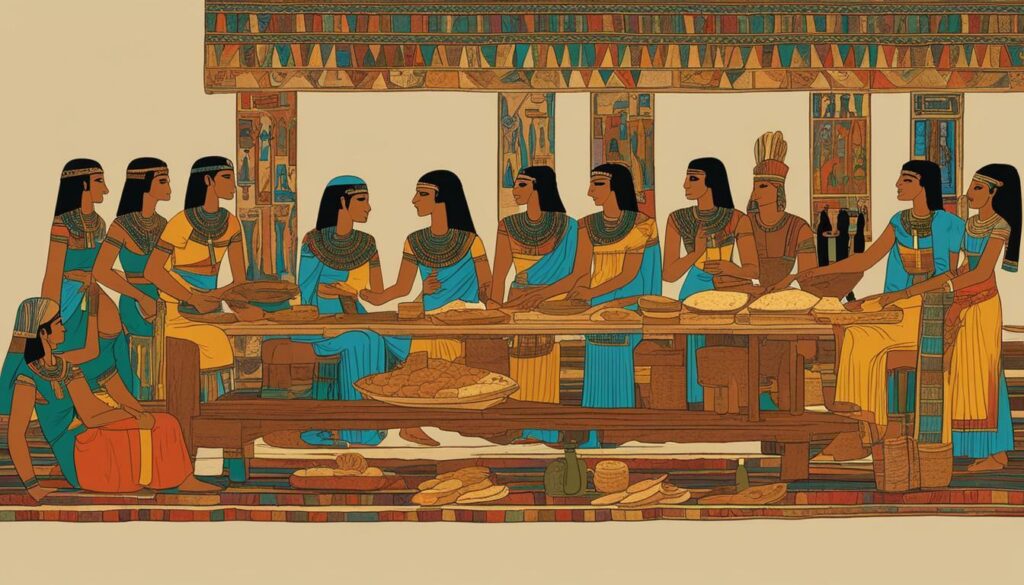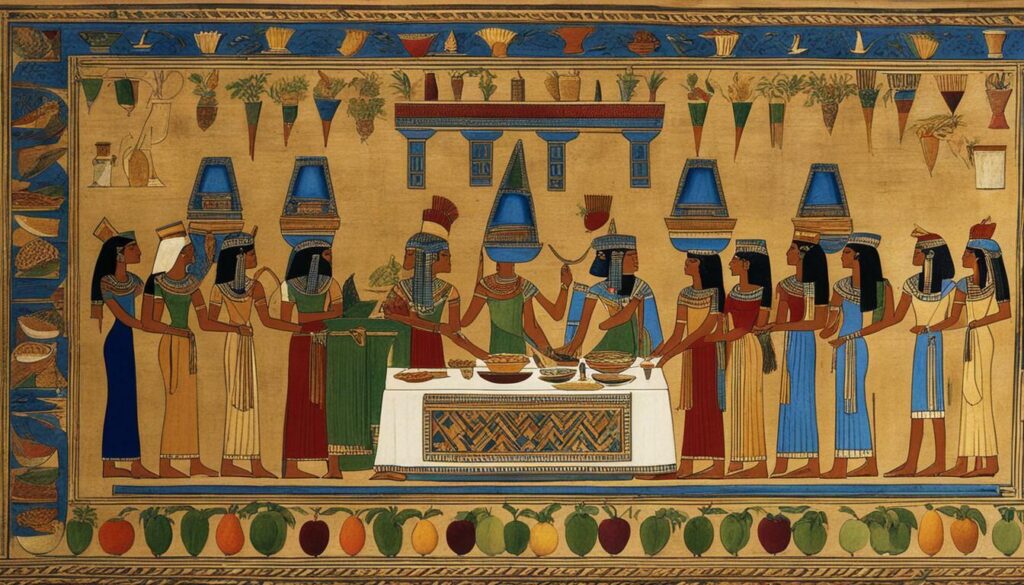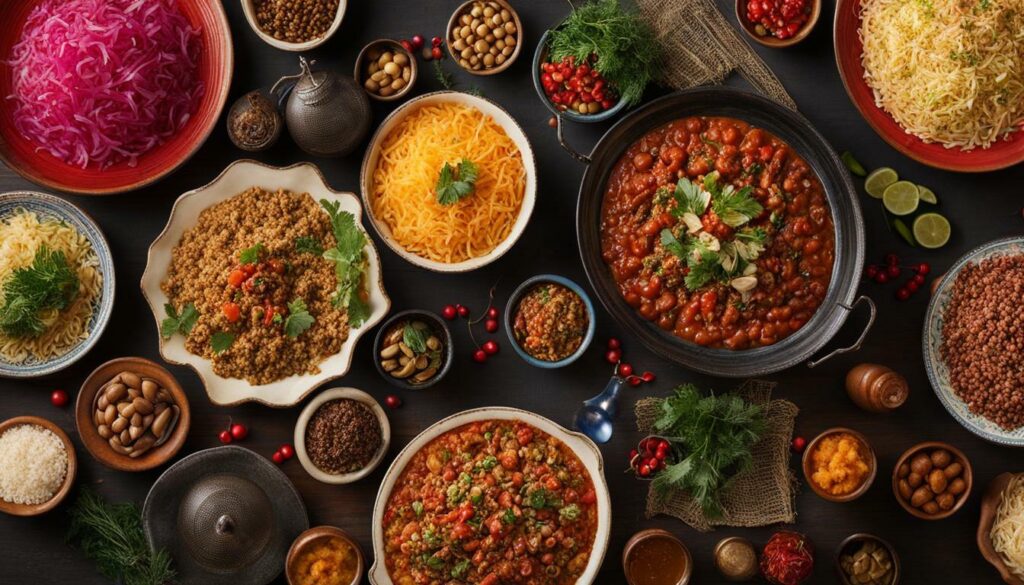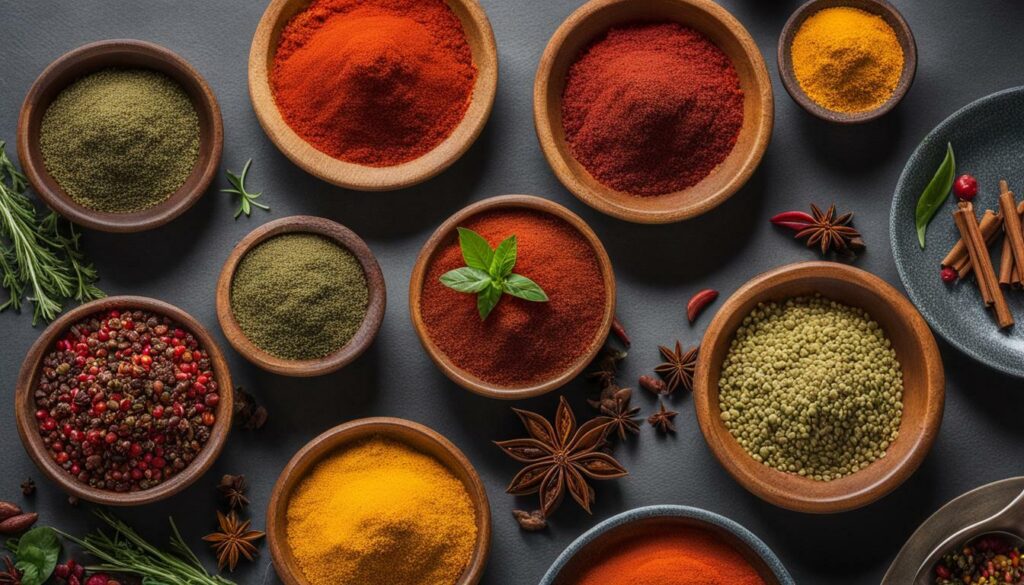Egypt’s rich culinary heritage is a fascinating blend of ancient traditions and contemporary influences, resulting in a diverse range of diet patterns throughout history. From the plant-based diet of ancient Egyptians to the modern fusion cuisine, the food culture of Egypt has evolved over time, shaped by factors such as geography, social status, and religious beliefs.
Key Takeaways:
- Ancient Egyptians primarily had a plant-based diet, focusing on grains, vegetables, and fruits.
- Protein sources in ancient Egyptian cuisine included legumes, fish, and meat, but meat consumption was relatively limited.
- Spices and herbs like cumin, coriander, and dill added flavour to ancient Egyptian dishes.
- Bread and beer were staple foods in ancient Egypt.
- Social status and wealth played a role in determining the variety of foods consumed, with the wealthy having access to a wider range of options.
The Diet of Ancient Egyptians
The diet of ancient Egyptians revolved around an abundance of plant-based foods, with grains, vegetables and fruits forming the foundation of their meals. Legumes, fish, and meat were also consumed, although meat was not as commonly eaten as other foods. Common spices and herbs such as cumin, coriander, and dill were used to enhance the flavours of their dishes. Honey was used as a natural sweetener, and dairy products like milk, cheese, and butter were included in their diet.

The staple foods of ancient Egyptians were bread and beer, which were consumed by people of all social classes. Bread was mostly made from emmer wheat, an ancient grain that is still cultivated in Egypt today. Beer was a common beverage, brewed from barley and flavoured with dates or other fruits. The diet of ancient Egyptians also varied based on social status and wealth, with the rich enjoying a wider variety of foods compared to the lower classes.
| Plant-Based Foods | Protein Sources | Staple Foods |
|---|---|---|
| Grains | Legumes | Bread |
| Vegetables | Fish | Beer |
| Fruits | Meat |
The Nile River played a vital role in shaping the ancient Egyptian diet. It provided water for livestock and crops, ensuring a consistent food supply. The fertility of the Nile’s floodplain allowed for the cultivation of a variety of crops, including grains and vegetables. Additionally, the Nile River was not only a source of sustenance but also held religious significance. Food was used in religious rituals and as offerings to the gods, further emphasizing the cultural importance of food in ancient Egyptian society.
The Role of Food in Religious Rituals
“Food played a crucial role in religious rituals and ceremonies in ancient Egypt. It was believed that offerings of food would sustain the gods and ensure their favor towards the people.”
The diet of ancient Egyptians has had a lasting impact on the cuisine of modern Egypt. Many traditional Egyptian foods and ingredients, such as emmer wheat, vegetables, fruits, and legumes, are still prominent in contemporary Egyptian dishes. The rich culinary heritage of ancient Egypt continues to be celebrated and enjoyed today, reflecting its significance in shaping the country’s food culture over thousands of years.
Protein Sources and Spices in Ancient Egyptian Cuisine
In addition to their plant-based diet, ancient Egyptians incorporated legumes, fish, and, to a lesser extent, meat into their meals as sources of protein, while spices and herbs like cumin, coriander, and dill added depth and flavour to their dishes. Legumes such as lentils, chickpeas, and fava beans were commonly consumed and provided a significant source of protein for the ancient Egyptians. Fish, including Nile perch and catfish, were abundant in the Nile River and served as an important protein source.
The consumption of meat was not as prevalent as other food sources in ancient Egyptian cuisine, but it still played a role in the diet. Beef, pork, and poultry were occasionally consumed, particularly during religious rituals and festivals. However, these meat sources were not as readily available to the general population due to their cost and limited access, making them more of a luxury for the wealthy.
Ancient Egyptians valued the use of spices and herbs in their cooking to enhance the flavours of their dishes. Cumin, coriander, and dill were among the most commonly used spices, adding aromatic and savoury notes to various recipes. Additionally, garlic and onions were frequently used for their medicinal properties and to enhance the taste of the food.

Protein Sources and Spices in Ancient Egyptian Cuisine
- Legumes – lentils, chickpeas, fava beans
- Fish – Nile perch, catfish
- Meat – beef, pork, poultry (limited consumption)
“Spices and herbs added depth and flavour to their dishes, with cumin, coriander, and dill being some of the most commonly used.”
| Protein Sources | Spices and Herbs |
|---|---|
| Legumes | Cumin |
| Fish | Coriander |
| Meat | Dill |
Egyptian Street Food Video Tour
Staple Foods and Dairy Consumption
Bread and beer held significant importance in the diet of ancient Egyptians, while dairy products like milk, cheese, and butter also found their place on their tables. Egyptians were skilled bakers and produced a variety of bread made from different types of grains, including barley and emmer wheat. Bread was a staple in their meals and was often accompanied by other dishes like stews or vegetables.
The most common type of bread consumed by ancient Egyptians was a flatbread called ta-en-ab, which translates to ‘bread of the land’. It was made by combining grain with water and yeast and then baking it in an oven. The bread was typically shaped into round loaves or elongated loaves, similar to modern-day baguettes. It had a dense texture and was often enjoyed with honey or dipped in oil.
The ancient Egyptians believed that the god Osiris had given them the gift of growing grains, and bread became a symbol of life and nourishment.
Beer was another staple in the ancient Egyptian diet. It was made from fermented barley and was consumed by people of all social classes, from workers to pharaohs. Beer provides hydration and nutrients, making it an essential part of daily life. The brewing process involved soaking barley grains in water and allowing them to ferment over a period of time. The result was a thick, porridge-like beverage, which was strained to remove any solids before consumption.
| Food | Description |
|---|---|
| Milk | Consumed in its raw form or used to make other dairy products like cheese and butter. |
| Cheese | Produced from the curdling of milk and was often seasoned with herbs and spices. |
| Butter | Used as a cooking fat and spread on bread. |
Not only were these foods an essential component of the ancient Egyptian diet, but they also held cultural and religious significance. Egyptians believed that bread and beer were gifts from the gods and played a role in religious rituals and offerings. The Nile River, with its fertile banks, provided the ideal conditions for farming grains and producing dairy products. Its annual flooding replenished the soil and allowed for abundant crop growth, ensuring a steady supply of ingredients for these staples.

Bread and Beer in Ancient Egyptian Culture
The consumption of bread and beer was deeply ingrained in ancient Egyptian culture. They were not just food items but were also used as offerings to the gods and in various religious ceremonies. Bread was associated with the divine as it represented the gift of life and sustenance.
Beer was considered a symbol of joy and celebration. It was not only consumed as a part of daily meals but also during festivals and special occasions. The brewing and sharing of beer fostered a sense of community and camaraderie among ancient Egyptians.
Social Status and Dietary Variation
The diet of ancient Egyptians was not uniform across all social classes, with the rich indulging in a wider array of food choices that showcased their elevated status. While the lower classes primarily relied on a plant-based diet consisting of grains, vegetables, and fruits, the wealthy had access to an assortment of delicacies and exotic ingredients.
Among the popular foods enjoyed by the upper class were game meat, including fowl and venison, which were considered a luxury. They also had a predilection for more expensive spices and herbs, such as saffron and cinnamon, to enhance the flavours of their meals. These extravagant ingredients were often imported from distant lands, further highlighting the wealth and prestige associated with consuming them.
In addition to their diverse food choices, the rich would host elaborate feasts and banquets as a means of displaying their affluence and hospitality. These festive occasions would feature a wide range of dishes, from roasted meats to indulgent desserts. Guests would be treated to an extravagant display of flavours and textures, accompanied by an abundance of wine and other beverages.

| Foods | Description |
|---|---|
| Roasted meats | Tender cuts of lamb, beef, or venison seasoned with aromatic spices |
| Honey-roasted figs | Fresh figs drizzled with honey and baked to perfection |
| Stuffed grape leaves | Tender grape leaves filled with a flavorful mixture of rice, herbs, and spices |
| Almond pastries | Delicate pastries filled with a sweet almond paste and sprinkled with powdered sugar |
Ancient Egyptian feasts were a display of opulence, with the rich showcasing their wealth through the abundance of food and lavish hospitality. These occasions provided an opportunity for the upper class to indulge in a variety of luxurious ingredients and exotic flavors, solidifying their social status within society.
The Role of the Nile River in Egyptian Food Culture
The Nile River, with its life-giving waters, not only sustained ancient Egyptians but also played a pivotal role in shaping their food culture and religious practices. As the longest river in the world, the Nile provided a constant source of water for livestock and fertile land for crop cultivation. This abundance of resources allowed the ancient Egyptians to develop a diverse and sustainable diet.
One of the key aspects of ancient Egyptian food culture was the reliance on agriculture. The fertile soil along the riverbanks allowed for the cultivation of crops such as wheat, barley, and vegetables. These staples formed the foundation of the ancient Egyptian diet, providing the necessary carbohydrates, vitamins, and minerals for sustenance.
Moreover, the Nile River facilitated the rearing of livestock such as cattle, goats, and sheep. These animals not only provided meat for consumption but also served as sources of milk, cheese, and butter. This diverse range of food options allowed the ancient Egyptians to create flavorful dishes that catered to different tastes and preferences.

The Role of Food in Religious Rituals and Preparation for the Afterlife in Ancient Egypt
In addition to its significance in sustenance, food held a central role in religious rituals and preparation for the afterlife in ancient Egypt. The belief in an afterlife shaped the way food was cultivated, prepared, and consumed. The ancient Egyptians believed that the deceased would need sustenance in the afterlife, and therefore, burial sites were often adorned with offerings of food and drink.
Religious festivals and ceremonies also involved the preparation and consumption of specific food items. Temples dedicated to various gods and goddesses would offer meals as part of the religious rituals, serving as a means of communication and connection with the divine. These meals often included bread, beer, and meat, symbolizing the essential elements of life.
Overall, the Nile River not only provided the ancient Egyptians with the resources needed for their sustenance but also shaped their food culture and religious practices. The rich agricultural lands and abundant water supply allowed for the cultivation of diverse crops and the rearing of livestock, leading to a varied and flavorful diet. Furthermore, food played a central role in religious rituals and preparation for the afterlife, reflecting the deep cultural and spiritual significance attached to nourishment in ancient Egypt.
The Influence of Ancient Egyptian Cuisine on Contemporary Diets
While the world has changed significantly since ancient times, the culinary traditions of Egypt continue to leave their mark on modern dishes, with traditional ingredients and flavours holding strong in contemporary Egyptian cuisine. Today, Egyptians still embrace the plant-based diet that their ancestors practised, incorporating staples like grains, vegetables, and fruits into their daily meals. The rich and diverse food culture of ancient Egypt is evident in the wide variety of Egyptian recipes that are passed down through generations.

One of the most popular dishes that showcase the influence of ancient Egyptian cuisine is koshari, a flavorful blend of rice, lentils, and pasta topped with a zesty tomato sauce and crispy onions. Koshari is a beloved comfort food in Egypt and is enjoyed by people from all walks of life. Other traditional dishes like ful medames (slow-cooked fava beans) and molokhia (a nutritious leafy green soup) continue to be enjoyed as well.
A key aspect of modern Egyptian fare is the use of local and fresh ingredients. Egyptians take pride in sourcing their produce from local markets and farms, ensuring that the flavours of their dishes are authentic and full of vibrant taste. The use of aromatic spices and herbs, such as cumin, coriander, and dill, adds depth and complexity to Egyptian recipes, exemplifying the ancient practice of incorporating these flavours into their culinary traditions.
In summary, the culinary traditions of ancient Egypt have left an indelible mark on contemporary Egyptian cuisine. From the plant-based diet and the consumption of staples like bread and beer to the use of traditional ingredients and spices, the influence of ancient Egyptian cuisine continues to be celebrated and preserved in modern-day Egypt. Whether enjoying traditional dishes or experimenting with new flavours, Egyptians take pride in their rich food culture that has stood the test of time.
Traditional Egyptian Festive Foods and Celebrations
From religious festivals to family gatherings, traditional Egyptian cuisine takes centre stage during festive occasions, offering a tantalizing array of dishes that celebrate both culture and flavour. These festive foods have been passed down through generations, preserving the rich culinary heritage of Egypt.
During religious festivals such as Eid al-Fitr and Eid al-Adha, families come together to celebrate and share meals. One popular dish is Fatta, made with layers of crispy bread, cooked meat, and a savoury sauce. It is a hearty and flavorful dish that symbolizes abundance and unity.

Another festive favourite is Molokhia, a dish made from the leaves of the jute plant. It is cooked with garlic, coriander, and flavorful broth, resulting in a thick and aromatic stew. Molokhia is often served with rice or bread and is enjoyed by both young and old during special occasions.
The Egyptians also take pride in their desserts, with Basbousa being a popular choice. This sweet semolina cake is soaked in a fragrant sugar syrup and often garnished with nuts. It is a delicious treat that brings a touch of sweetness to festive gatherings.
The Charm of Festive Foods
These traditional Egyptian festive foods not only delight the taste buds but also serve as a reminder of the country’s cultural heritage. They showcase the unique blend of flavours, ingredients, and cooking techniques that have been passed down through the ages.
Whether it’s a big celebration or an intimate family gathering, the festive foods of Egypt bring people together, creating cherished memories and honouring their rich culinary traditions.
| Festive Dish | Description |
|---|---|
| Fatta | A dish made with layers of crispy bread, cooked meat, and a savory sauce, symbolizing abundance and unity. |
| Molokhia | A stew made from jute leaves, cooked with garlic, coriander, and flavorful broth, often served with rice or bread. |
| Basbousa | A sweet semolina cake soaked in a fragrant sugar syrup and garnished with nuts. |
The Ever-Popular Egyptian National Dish
No exploration of Egyptian cuisine would be complete without mentioning the national dish, a culinary masterpiece that encapsulates the essence of Egypt’s food culture. This beloved dish, known as koshari, is a delightful combination of flavours and textures that has been enjoyed by Egyptians for generations.
Koshari is a hearty and satisfying dish that consists of layers of rice, lentils, and macaroni, topped with a spicy tomato sauce and crispy fried onions. The combination of ingredients creates a harmonious symphony of tastes, with the tanginess of the tomato sauce complementing the earthiness of the lentils and rice, while the fried onions add a crunchy element to each bite.

What makes koshari truly unique is not only its delicious flavours but also its cultural significance. As the national dish of Egypt, it represents the diversity and unity of the Egyptian people. Its humble origins can be traced back to the 19th century when it was initially created as a cheap and filling meal for the working class. Over time, it gained popularity across all social classes and became a symbol of national identity.
Today, koshari can be found in households and restaurants throughout Egypt. It is often enjoyed as a main course during lunch or dinner, and its affordability and flavorful taste have made it a staple street food as well. Whether you’re a visitor to Egypt or a local, indulging in a plate of koshari is an essential experience that allows you to savour the rich history and culture of this remarkable country.
The Diversity of Egyptian Regional Cuisines
Egyptian cuisine is a tapestry of diverse regional flavours, where each corner of the country adds its own distinct touch to beloved traditional dishes. From the vibrant spices of the coastal cities to the hearty stews of the Nile Delta, every region offers its unique culinary delights.
In Upper Egypt, dishes like “Kushari” steal the spotlight. This comforting dish combines pasta, rice, lentils, chickpeas, caramelized onions, and a tangy tomato sauce. It’s a hearty, filling meal that represents the rich agricultural heritage of the region.
The Western Desert brings its own flair with “Feseekh,” a fermented fish dish that has been enjoyed for centuries. This delicacy is prepared by salting and drying small fish, typically mullet, to be consumed during the spring festival of Sham El Nessim. Feseekh is an acquired taste, cherished by those who appreciate its pungent aroma and unique texture.
| Region | Traditional Dish |
|---|---|
| Upper Egypt | Kushari |
| Western Desert | Feseekh |
In coastal cities, such as Alexandria, seafood takes centre stage. “Sayadieh” is a classic Alexandrian dish made with tender fish, fragrant rice, caramelized onions, and a medley of spices. It’s a true representation of the city’s maritime heritage and is best enjoyed with a squeeze of fresh lemon juice.
Heading towards the Sinai Peninsula, “Sawabe’ Zbeet” awaits. This comforting dessert is a blend of caramelized sweet potatoes, cinnamon, and a touch of orange blossom water. It’s a delightful sweet treat that perfectly complements the savoury dishes found throughout the region.
Egyptian cuisine is a treasure trove of diverse flavors, influenced by the geography, history, and culture of each region. From the bustling cities to the serene oases, every corner of Egypt offers its own culinary wonders. Exploring the regional cuisines is like embarking on a delicious journey, where the taste buds are treated to a multitude of flavors and textures. Whether indulging in Kushari in Upper Egypt or savoring Sayadieh in Alexandria, each dish tells a story of Egypt’s rich culinary heritage.

The Bounty of Egypt’s Culinary Heritage
Egyptian cuisine is not just confined to these few examples. Each governorate, town, and village in Egypt has its own unique dishes and culinary traditions that contribute to the rich tapestry of Egyptian cuisine. Exploring the diverse regional flavours of Egypt is a gastronomic adventure that unveils the country’s rich history, cultural diversity, and agricultural abundance.
As you travel through Egypt, be sure to indulge in the regional specialities and experience the flavours that have been passed down through generations. From the spice markets of Cairo to the street food stalls of Luxor, the variety of dishes will tantalize your taste buds and leave you with a deeper appreciation for the rich culinary heritage of Egypt.
The Future of Egyptian Food
As Egypt embraces the ever-evolving world of food, the future of Egyptian cuisine holds exciting possibilities, with a blend of traditional recipes and innovative culinary techniques. With an abundance of fresh ingredients, a rich cultural heritage, and a growing interest in gastronomy, Egyptian cuisine is poised for a culinary renaissance.
In recent years, there has been a surge in Egyptian chefs and food entrepreneurs who are reviving traditional recipes and reimagining them for modern palates. By combining classic flavours with contemporary presentation and cooking methods, they are introducing the world to a new wave of Egyptian cuisine. From the bustling street food scene to high-end restaurants, Egyptian chefs are showcasing the diverse flavours and regional specialities that make Egyptian food so unique.
The use of locally sourced, sustainable ingredients is also becoming more prominent in Egyptian food culture. Chefs and home cooks alike are increasingly conscious of the impact their food choices have on the environment. As a result, there is a growing emphasis on seasonal produce, organic farming practices, and reducing food waste.
Furthermore, the influence of international cuisines is shaping the future of Egyptian food. As Egypt continues to attract tourists and expatriates from around the globe, culinary influences from different cultures are finding their way into Egyptian kitchens. Fusion dishes that combine traditional Egyptian flavours with international ingredients and techniques are becoming more common, creating a unique culinary tapestry that reflects Egypt’s multicultural society.
Innovation and tradition go hand in hand
Despite the influx of new culinary trends, traditional Egyptian recipes and cooking methods remain at the heart of Egyptian cuisine. Generations-old family recipes are cherished and passed down, keeping the flavours of the past alive. Egyptian classics like koshari, molokhia, and ful medames continue to be beloved staples in homes and restaurants across the country.
The future of Egyptian food lies in striking a balance between innovation and tradition. By preserving the authenticity of traditional recipes while embracing new culinary techniques and global influences, Egyptian cuisine can continue to evolve and captivate the taste buds of both locals and visitors.
“Egyptian cuisine is a true reflection of our rich history and vibrant culture. As we look to the future, we are excited to see how our culinary heritage will adapt and thrive, offering new and exciting experiences for food enthusiasts worldwide.”

| Traditional Egyptian Dishes | Regional Specialties | Modern Innovations |
|---|---|---|
| Koshari | Siwa Oasis Dates | Fusion Desserts |
| Molokhia | Alexandrian Seafood | Vegetarian and Vegan Options |
| Ful Medames | Aswan’s Nubian Cuisine | Artisanal Food Products |
With its rich history, diverse flavours, and a new generation of culinary innovators, Egyptian cuisine is poised to make a lasting impact on the global food scene. As Egypt looks towards the future, it will continue to celebrate its culinary heritage while embracing new culinary horizons, ensuring that Egyptian food remains a feast for the senses for generations to come.
Conclusion
The past and present diets of Egypt intertwine, offering a tantalizing journey through time that reveals the enduring legacy of ancient culinary traditions in contemporary Egyptian dishes. Ancient Egyptians followed a primarily plant-based diet, with an emphasis on grains, vegetables, and fruits. Legumes, fish, and meat provided sources of protein, although meat was not as commonly consumed as other foods. Spices and herbs like cumin, coriander, and dill added flavour to their meals, while honey served as a sweetener.
Bread and beer held a special place in their diet as staple foods, and dairy products like milk, cheese, and butter were also consumed. The variation in diet was influenced by social status and wealth, with the wealthy having access to a wider array of foods compared to the lower classes.
The Nile River played a crucial role in shaping the ancient Egyptian diet. Its water provided for the nourishment of livestock and fertile land for growing crops. Food also held significance in religious rituals and preparations for the afterlife, adding a spiritual dimension to the culinary culture of ancient Egypt.
Today, the traditional food culture of ancient Egypt continues to influence the contemporary Egyptian diet. Staples like emmer wheat, vegetables, fruits, and legumes are still widely consumed, connecting modern Egyptians to their rich culinary heritage. Festive foods and celebrations showcase the diversity and vibrancy of Egyptian cuisine, while the national dish serves as a symbol of national identity.
The future of Egyptian food holds the promise of fusion cuisine and the incorporation of contemporary food trends. As the culinary landscape evolves, the past will continue to inform the present, ensuring that the legacy of ancient Egyptian cuisine lives on in the delicious dishes that grace the tables of Egypt.
FAQ
What was the diet of ancient Egyptians?
The diet of ancient Egyptians was primarily plant-based, with a focus on grains, vegetables, and fruits. They also consumed legumes, fish, and meat as sources of protein, but meat was not as commonly consumed as other foods.
What spices and herbs were commonly used in ancient Egyptian cuisine?
Common spices and herbs used in ancient Egyptian cuisine included cumin, coriander, and dill.
What sweetener did ancient Egyptians use?
Ancient Egyptians used honey as a sweetener in their food.
Did ancient Egyptians consume dairy products?
Yes, ancient Egyptians consumed dairy products like milk, cheese, and butter.
What were the staple foods of ancient Egyptians?
Bread and beer were staple foods in ancient Egypt.
Did the diet of ancient Egyptians vary based on social status?
Yes, the diet of ancient Egyptians varied based on social status and wealth, with the rich having access to a wider variety of foods.
What role did the Nile River play in ancient Egyptian food culture?
The Nile River played a crucial role in providing water for livestock and keeping the land fertile for crops, which influenced the ancient Egyptian diet.
How has the traditional food culture of ancient Egypt influenced contemporary diets in Egypt?
The traditional food culture of ancient Egypt continues to influence contemporary diets in Egypt, with staples like emmer wheat, vegetables, fruits, and legumes still being consumed today.
What were some traditional festive foods and celebrations in ancient Egypt?
Ancient Egyptians had traditional festive foods and celebrations associated with special occasions, showcasing the culinary delights of the culture.
Is there a national dish in Egypt?
Yes, Egypt has a popular national dish that represents the essence of Egyptian cuisine and serves as a symbol of national identity.
How diverse is Egyptian regional cuisine?
Egyptian regional cuisine is diverse, with each region boasting its own unique flavours, ingredients, and cooking techniques.
How is the future of Egyptian food shaping up?
The future of Egyptian food is influenced by contemporary food trends and the potential for fusion cuisine, which is shaping the culinary landscape in Egypt.
Source Links
- https://www.historyhit.com/the-diet-of-the-nile-what-did-the-ancient-egyptians-eat/
- https://monisbukhari.medium.com/exploring-the-ancient-egyptian-diet-grains-vegetables-and-beer-62b3ec925221
- https://journalofethnicfoods.biomedcentral.com/articles/10.1186/s42779-023-00177-4
Explore More About Egypt and Its Regions Here:
| Past and Present Diets of Mediterranean |
| Past and Present Diets of the Indian Subcontinent |



